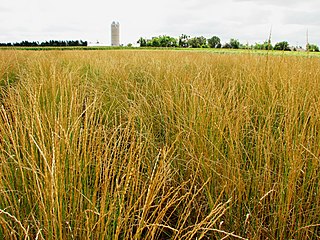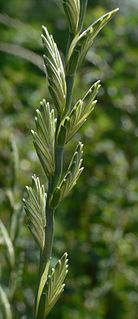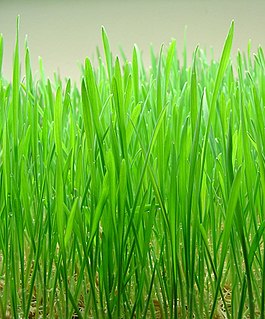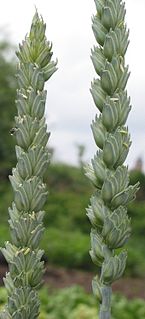
Poaceae or Gramineae is a large and nearly ubiquitous family of monocotyledonous flowering plants known as grasses, commonly referred to collectively as grass. Poaceae includes the cereal grasses, bamboos and the grasses of natural grassland and cultivated lawns and pasture. Grasses have stems that are hollow except at the nodes and narrow alternate leaves borne in two ranks. The lower part of each leaf encloses the stem, forming a leaf-sheath. With around 780 genera and around 12,000 species, Poaceae are the fifth-largest plant family, following the Asteraceae, Orchidaceae, Fabaceae and Rubiaceae.
Forage is a plant material eaten by grazing livestock.
Historically, the term forage has meant only plants eaten by the animals directly as pasture, crop residue, or immature cereal crops, but it is also used more loosely to include similar plants cut for fodder and carried to the animals, especially as hay or silage. The term forage fish refers to small schooling fish that are preyed on by larger aquatic animals.

Bromus is a large genus of grasses, classified in its own tribe Bromeae. They are commonly known as bromes, brome grasses, cheat grasses or chess grasses. Estimates in the scientific literature of the number of species have ranged from 100 to 400, but plant taxonomists currently recognize around 160–170 species.

The Pooideae are the largest subfamily of the grass family Poaceae, with over 4,200 species in 14 tribes and roughly 200 genera. They include some major cereals such as wheat, barley, oat, rye and many lawn and pasture grasses. They are often referred to as cool-season grasses, because they are distributed in temperate climates. All of them use the C3 photosynthetic pathway.

Pascopyrum is a monotypic genus of grass containing the sole species Pascopyrum smithii, which is known by the common name western wheatgrass, though the common nickname is red-joint wheatgrass, from the red coloration of the nodes. This is a sod-forming rhizomatous perennial grass which is native and common throughout most of North America. It grows in grassland and prairie in the Great Plains, where it is sometimes the dominant grass species. It is the state grass of North Dakota, South Dakota, and Wyoming.

Triticeae is a botanical tribe within the subfamily Pooideae of grasses that includes genera with many domesticated species. Major crop genera found in this tribe include wheat, barley, and rye; crops in other genera include some for human consumption and others used for animal feed or rangeland protection. Among the world's cultivated species, this tribe has some of the most complex genetic histories. An example is bread wheat, which contains the genomes of three species, only one of them originally a wheat Triticum species. Seed storage proteins in the Triticeae are implicated in various food allergies and intolerances.

Agropyron cristatum is a species in the Poaceae family. This plant is often used as forage and erosion control. It is well known as a widespread introduced species on the prairies of the United States and Canada.
Agropyron desertorum is a species in the Poaceae family which was originally from Russian and Siberian steppes until it was introduced to the United States from there between 1907 and 1913. Prior to its introduction it was believed that Desert wheatgrass and crested wheatgrass are different species. Currently it can still be found in Central and Western United States, except for Idaho, Kansas, Louisiana, Minnesota, Oklahoma, and Washington.
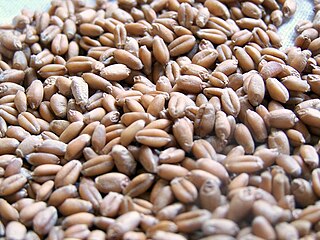
A wheat berry, or wheatberry, is a whole wheat kernel, composed of the bran, germ, and endosperm. Botanically, it is a type of fruit called a caryopsis. Wheat berries have a tan to reddish-brown color and are available as either a hard or soft processed grain. They are often added to salads or baked into bread to add a crunchy texture. If wheat berries are milled, whole-wheat flour is produced.
Charles Franklin Schnabel (1895-1974) was an American agricultural chemist who became known as the father of wheatgrass. Dr. Schnabel opened the door to scientific research on cereal grass. After Schnabel's initial work in the mid 1920s that showed chickens nearly tripled their winter egg production when a small amount of cereal grass was added to their diet, he went on to find benefits with nearly every kind of livestock. His research documented larger litters, richer milk, more milk, less infant mortality, better fur and improved general health when a small amount of dehydrated cereal grass was added to the animal's food ration. In 1970, he accurately predicted, due to its climate similar to Johannesburg that, "San Diego will be the wheat grass capital of the United States."

Elymus elymoides is a species of wild rye known by the common name squirreltail. This grass is native to most of North America west of the Mississippi River and occurs in a number of ecosystems, from the alpine zone to desert sage scrub to valley grassland.
Wheat is a grass widely cultivated for its seed, a cereal grain which is a worldwide staple food.

A grain is a small, hard, dry seed, with or without an attached hull or fruit layer, harvested for human or animal consumption. A grain crop is a grain-producing plant. The two main types of commercial grain crops are cereals and legumes.
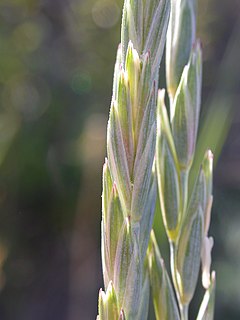
Elymus lanceolatus is a species of grass known by the common names thickspike wheatgrass and streamside wheatgrass. It is native to North America, where it is widespread and abundant in much of Canada and the western and central United States. There are two subspecies, ssp. lanceolatus occurring throughout the species' range and ssp. psammophilus occurring in the Great Lakes region. Elymus lanceolatus is a perennial, low growing, rhizomatous grass that actively grows in summer and spring. This plant is native to semiarid regions of the United States. Elymus lanceolatus is polymorphic, capable of growing in high altitude regions of the Rocky Mountains or at sea level near the Great Lakes in the United States. The bloom period for E. lanceolatus is mid-spring, and it is available commercially. Elymus lanceolatus is characterized by its yellow flowers, green or grey leaves, and brown seeds. According to the United States Department of Agriculture (USDA), it has a moderate harvest regrowth rate. Wheatgrass is unique in that in can adapt to fine, medium, and coarsely textured soils in the environment. However, it is shade intolerant, has a medium fertility requirement, and has a medium salinity tolerance. Studies suggest that amounts of soil needed for wheatgrass harvest can be approximated by understanding the plant’s water depletion rate and rainfall amount in the region, which consequently helps reduce drainage.

Muhlenbergia cuspidata is a species of grass known by the common name plains muhly. It is native to North America where it is distributed across central Canada and the central United States.
